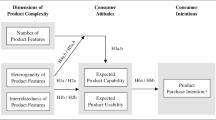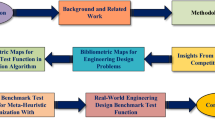Abstract
Interactive genetic algorithms (IGAs) have been applied in industrial design to quickly respond to customers’ personalized demand and to achieve customization. However, unreasonable recognition and improper configuration of customization attributes may increase the design complexity, impair efficiency and lead to user fatigue. In this paper, a combined Kano model and IGA approach is proposed for more effective product customization to conduct customer-driven product design by fully considering their individual preferences and simultaneously enhancing effective user involvement. The approach uses the Kano model to recognize different customization attributes and rank them in order of their influence on customer satisfaction. The model then dynamically adjusts these attributes for customization in the IGA-based product design process to more quickly find a satisfying design scheme without leading to user fatigue. A computer-aided design system prototype is developed in the context of the customized design of tablet PCs to prove the maneuverability and effectiveness of the proposed approach. The experimental results demonstrate that the approach could improve customization efficiency to a large extent and fully relieve user fatigue by expediting the process of finding satisfying design individuals for customers.








Similar content being viewed by others
References
Åhlström, P., & Westbrook, R. (1999). Implications of mass customization for operations management: An exploratory survey. International Journal of Operations and Production Management, 19(3), 262–275.
Berger, C., Blauth, R., Boger, D., Bolster, C., Burchill, G., DuMouchel, W., et al. (1993). Kano’s methods for understanding customer-defined quality. Center for Quality Management Journal, 2(4), 3–35.
Bernhardt, D., Liu, Q., & Serfes, K. (2007). Product customization. European Economic Review, 51(6), 1396–1422.
Bush, B. J., & Sayama, H. (2011). Hyperinteractive evolutionary computation. IEEE Transactions on Evolutionary Computation, 15(3), 424–433.
Cavusoglu, H., Cavusoglu, H., & Raghunathan, S. (2007). Selecting a customization strategy under competition: Mass customization, targeted mass customization, and product proliferation. IEEE Transactions on Engineering Management, 54(1), 12–28.
Chen, C. C., & Chuang, M. C. (2008). Integrating the Kano model into a robust design approach to enhance customer satisfaction with product design. International Journal of Production Economics, 114(2), 667–681.
Chen, L. S., Liu, C. H., Hsu, C. C., & Lin, C. S. (2010). C-Kano model: A novel approach for discovering attractive quality elements. Total Quality Management and Business Excellence, 21(11), 1189–1214.
Cho, S. B. (2002). Towards creative evolutionary systems with interactive genetic algorithm. Applied Intelligence, 16(2), 129–138.
Choi, S., Jung, K., & Noh, S. D. (2015). Virtual reality applications in manufacturing industries: Past research, present findings, and future directions. Concurrent Engineering-Research and Applications, 23(1), 40–63.
Dahl, D. W., Fuchs, C., & Schreier, M. (2015). Why and when consumers prefer products of user-driven firms: A social identification account. Management Science, 61(8), 1978–1988.
Dou, R., & Zong, C. (2014). Application of interactive genetic algorithm based on hesitancy degree in product configuration for customer requirement. International Journal of Computational Intelligence Systems, 7(sup2), 74–84.
Du, X., Jiao, J., & Tseng, M. M. (2005). Understanding customer satisfaction in product customization. The International Journal of Advanced Manufacturing Technology, 31(3–4), 396–406.
Franke, N., Schreier, M., & Kaiser, U. (2010). The “I Designed It Myself” effect in mass customization. Management Science, 56(1), 125–140.
Fu, Y. P., Wang, H. F., Huang, M., & Wang, J. W. (2016). A decomposition based multiobjective genetic algorithm with adaptive multipopulation strategy for flowshop scheduling problem. Natural Computing. http://hub.hku.hk/handle/10722/227310.
Goldberg, D. E., & Holland, J. H. (1988). Genetic algorithms and machine learning. Machine Learning, 3(2), 95–99.
Gong, D., Yao, X., & Yuan, J. (2009). Interactive genetic algorithms with individual fitness not assigned by human. Journal of Universal Computer Science, 15(13), 2446–2462.
Gong, D., Zhou, Y., & Li, T. (2005). Cooperative interactive genetic algorithm based on user’s preference. International Journal of Information Technology, 11(10), 1–10.
Helo, P. T., Xu, Q. L., Kyllönen, S. J., & Jiao, R. J. (2010). Integrated vehicle configuration system-connecting the domains of mass customization. Computers in Industry, 61(1), 44–52.
Hinckeldeyn, J., Dekkers, R., Altfeld, N., & Kreutzfeldt, J. (2014). Expanding bottleneck management from manufacturing to product design and engineering processes. Computers and Industrial Engineering, 76, 415–428.
Holland, J. H. (1973). Genetic algorithms and the optimal allocation of trials. Siam Journal on Computing, 2(2), 88–105.
Hsiao, S. W., Chiu, F. Y., & Lu, S. H. (2010). Product-form design model based on genetic algorithms. International Journal of Industrial Ergonomics, 40(3), 237–246.
Kano, N., Seraku, N., Takahashi, F., & Tsuji, S. (1984). Attractive quality and must-be quality. The Journal of the Japanese Society for Quality Control, 14(2), 39–48.
Kim, H. S., & Cho, S. B. (2000). Application of interactive genetic algorithm to fashion design. Engineering applications of artificial intelligence, 13(6), 635–644.
Kowaliw, T., Dorin, A., & McCormack, J. (2012). Promoting creative design in interactive evolutionary computation. Ieee Transactions on Evolutionary Computation, 16(4), 523–536.
Lee, J. H., & Chang, M. L. (2010). Stimulating designers’ creativity based on a creative evolutionary system and collective intelligence in product design. International Journal of Industrial Ergonomics, 40(3), 295–305.
Li, S., Nahar, K., & Fung, B. C. M. (2013). Product customization of tablet computers based on the information of online reviews by customers. Journal of Intelligent Manufacturing, 26(1), 97–110.
Llinares, C., & Page, A. F. (2011). Kano’s model in Kansei engineering to evaluate subjective real estate consumer preferences. International Journal of Industrial Ergonomics, 41(3), 233–246.
Luor, T., Lu, H. P., Chien, K. M., & Wu, T. C. (2015). Contribution to quality research: A literature review of Kano’s model from 1998 to 2012. Total Quality Management and Business Excellence, 26(3–4), 234–247.
Maruca, R. F. (2000). Mapping the world of customer satisfaction. Harvard Business Review, 78(3), 30.
Matzler, K., & Hinterhuber, H. H. (1998). How to make product development projects more successful by integrating Kano’s model of customer satisfaction into quality function deployment. Technovation, 18(1), 25–38.
Mok, P. Y., Xu, J., Wang, X. X., Fan, J. T., Kwok, Y. L., & Xin, J. H. (2013). An IGA-based design support system for realistic and practical fashion designs. Computer-Aided Design, 45(11), 1442–1458.
Park, J., Han, S. H., Kim, H. K., Oh, S., & Moon, H. (2013). Modeling user experience: A case study on a mobile device. International Journal of Industrial Ergonomics, 43(2), 187–196.
Petiot, J. F., & Dagher, A. (2010). Preference-oriented form design: Application to cars’ headlights. International Journal on Interactive Design and Manufacturing (IJIDeM), 5(1), 17–27.
Renner, G., & Ekárt, A. (2003). Genetic algorithms in computer aided design. Computer-Aided Design, 35(8), 709–726.
Rodriguez, L., Diago, L., & Hagiwara, I. (2011). Interactive genetic algorithm with fitness modeling for the development of a color simulation system based on customer’s preference. Japan Journal of Industrial and Applied Mathematics, 28(1), 27–42.
Smith, S., Smith, G. C., Jiao, R., & Chu, C. H. (2012). Mass customization in the product life cycle. Journal of Intelligent Manufacturing, 24(5), 877–885.
Takagi, H. (2001). Interactive evolutionary computation: Fusion of the capabilities of EC optimization and human evaluation. Proceedings of the IEEE, 89(9), 1275–1296.
Thirumalai, S., & Sinha, K. K. (2011). Customization of the online purchase process in electronic retailing and customer satisfaction: An online field study. Journal of Operations Management, 29(5), 477–487.
Violante, M. G., & Vezzetti, E. (2014). A methodology for supporting requirement management tools (RMt) design in the PLM scenario: An user-based strategy. Computers in Industry, 65(7), 1065–1075.
Wang, H., Fu, Y., Huang, M., Huang, G., & Wang, J. (2016a). A hybrid evolutionary algorithm with adaptive multi-population strategy for multi-objective optimization problems. Soft Computing. doi:10.1007/s00500-016-2414-5.
Wang, H., Fu, Y., Huang, M., & Wang, J. (2016b). Multiobjective optimisation design for enterprise system operation in the case of scheduling problem with deteriorating jobs. Enterprise Information Systems, 10(3), 268–285.
Wang, J., Liu, D., Ip, W. H., Zhang, W., & Deters, R. (2014a). Integration of system-dynamics, aspect-programming, and object-orientation in system information modeling. IEEE Transactions on Industrial Informatics, 10(2), 847–853.
Wang, J. W., Gao, F., & Ip, W. H. (2010). Measurement of resilience and its application to enterprise information systems. Enterprise Information Systems, 4(2), 215–223.
Wang, J. W., Wang, H. F., Zhang, W. J., Ip, W. H., & Furuta, K. (2014b). On a unified definition of the service system: What is its identity? IEEE Systems Journal, 8(3), 821–826.
Xu, Q., Jiao, R. J., Yang, X., Helander, M., Khalid, H. M., & Opperud, A. (2009). An analytical Kano model for customer need analysis. Design Studies, 30(1), 87–110.
Yang, C. C. (2011). Constructing a hybrid Kansei engineering system based on multiple affective responses: Application to product form design. Computers and Industrial Engineering, 60(4), 760–768.
Yang, Y., Zhang, X., Liu, F., & Xie, Q. (2005). An internet-based product customization system for CIM. Robotics and Computer-Integrated Manufacturing, 21(2), 109–118.
Yannou, B., Cluzel, F., & Dihlmann, M. (2013). Evolutionary and interactive sketching tool for innovative car shape design. Mechanics and Industry, 14(1), 1–22.
Zhang, W., & Wang, J. W. (2016). Design theory and methodology for enterprise systems. Enterprise Information Systems, 10(3), 245–248.
Acknowledgements
This research is partially supported by research grants from the National Natural Science Foundation of China under Grant Nos.71201115, 71471128 and 71271148. The authors are very grateful to all anonymous reviewers whose invaluable comments and suggestions substantially helped improve the quality of the paper.
Author information
Authors and Affiliations
Corresponding author
Rights and permissions
About this article
Cite this article
Dou, R., Zhang, Y. & Nan, G. Application of combined Kano model and interactive genetic algorithm for product customization. J Intell Manuf 30, 2587–2602 (2019). https://doi.org/10.1007/s10845-016-1280-4
Received:
Accepted:
Published:
Issue Date:
DOI: https://doi.org/10.1007/s10845-016-1280-4




